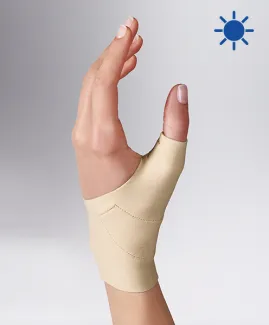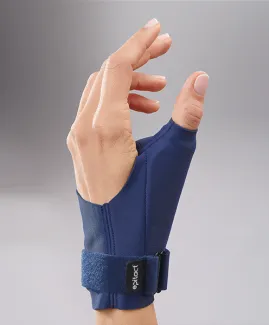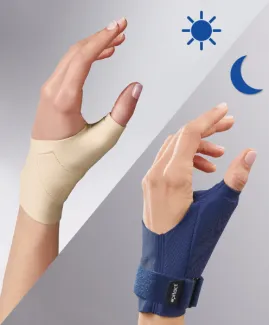
Thumb osteoarthritis is the most frequent type of hand osteoarthritis after osteoarthritis of the third joint at the extremity of a finger (distal interphalangeal joints). It was first described by Forestier in 1937 and referred to as ‘thumb basal joint arthritis’. This disorder most often concerns women and can cause significant pain and functional discomfort. But can men be affected by thumb osteoarthritis? In which cases does this condition most often appear?
A very female disease...
Thumb osteoarthritis is a joint condition. The cartilage wear and tear causes pain and progressively gives rise to a particularly disabling M-shaped thumb deformity.
Women are more frequently affected than men with a ratio of 3:1(1). Between 80% and 90% of the cases are postmenopausal women. This high prevalence in women over 50 years of age suggests an impact on tissues during post-menopausal hormonal changes.
However, men can also have thumb osteoarthritis, but this would only represent 2 to 5% of cases and occurs in patients over 50(2).
This prevalence would increase with age and loss of muscle strength of the thenar eminence (round-shaped muscle located under the thumb, on the palmar surface).
Aggravating factors of thumb osteoarthritis
In 90% of cases, this condition has mechanical causes, that is to say it is linked with joint anatomy. It can occur after traumas or microtraumas, be due to functional joint hypermobility or caused by inflammatory rheumatic disease like rheumatoid arthritis. It is also possible that this condition manifests with distal interphalangeal joints and/or general osteoarthritis. An abnormality during bone formation could cause poor use of the joint and inappropriate distribution of mechanical forces. As a consequence, it facilitates the onset of thumb osteoarthritis.
It is also possible that specific occupational activities that entail frequent prehension and recurrent vibrations would aid the development of thumb osteoarthritis. It is considered a musculoskeletal disorder of the upper limb. However, thumb osteoarthritis is currently not admitted as an occupational disease.
Thumb osteoarthritis: prevention is better that cure
This saying is well known but still insufficiently put into practice. Soft solutions allow the thumb joint to rest, relieve pain and limit the movements that favour cartilage wear and tear.
EPITACT® has designed a flexible brace for day use* to intuitively avoid traumatic micromovements for the joint. As for it, the rigid thumb brace* for thumb osteoarthritis perfectly adapts to your shape, holds the joint in a resting position and soothes pain.
For more advanced cases, these solutions can be completed by pharmacological options.
*These solutions are class I medical devices that bear the CE marking under this regulation. Carefully read the instructions before use. Manufacturer: Millet Innovation. 03/2022
For more details about this general and simplified approach, here are further sources:
(1)Fernández-de-las-Peñas C, Fernández-Muñoz JJ, Palacios-Ceña M, Navarro-Pardo E, Ambite-Quesada S, Salom-Moreno J. Direct and Indirect Effects of Function in Associated Variables Such as Depression and Severity on Pain Intensity in Women with Carpal Tunnel Syndrome. Pain Medicine. 1 déc 2015;16(12):2405‑11.
(2)Haara MM, Heliovaara M, Kroger H, et al. Osteoarthritis in the carpometacarpal joint of the thumb. Prevalence and associations with disability and mortality. J Bone Joint Surg Am 2004;86:1425–57. 05/2012 110 15. 05/2018 05/360
 Pharmacie
Pharmacie

